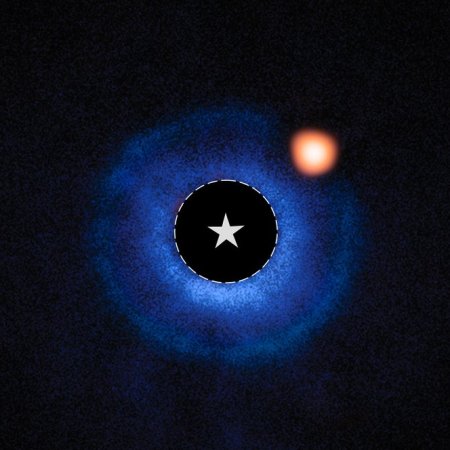Webb takes infrared image of exoplanet
Using the Webb Space Telescope astronomers have now successfully taken an infrared false-color image of Saturn-sized exoplanet orbiting a young star about half the mass of the Sun and about 111 light years away.
The image is to the right, cropped and reduced to post here. The star, its light blocked out, is indicated by the circle with the star in the middle. The exoplanet is the orange blob to the upper right, sitting inside the blue accretion disk that surrounds the star, photographed in optical light by the Very Large Telescope in Chile.
You can read the paper here. The scientists rejected the possibility that this was a background galaxy after doing computer modeling, based on the data available. From their paper:
Dedicated N-body simulations were conducted for a planet with a mass of 0.34 [mass of Jupiter], located at 52 au [astronomical units] around the 0.46 [solar mass] central star. This value is consistent with the measured projected separation, assuming that the planet and the ≈13°-inclined disk are coplanar. The simulation also included a disk of 200,000 planetesimals, distributed between 20 and 130 au. These parameters were selected to roughly match the boundaries of the observed disk.
Note too that the picture to the right has been significantly enhanced by the press department at JPL, based on the actual data shown in the paper itself. These fact underline the uncertainties involved in this discovery.
Nonetheless, it is a good result, and suggests we are looking at the formation process of a new solar system surrounding a very young baby star.
On Christmas Eve 1968 three Americans became the first humans to visit another world. What they did to celebrate was unexpected and profound, and will be remembered throughout all human history. Genesis: the Story of Apollo 8, Robert Zimmerman's classic history of humanity's first journey to another world, tells that story, and it is now available as both an ebook and an audiobook, both with a foreword by Valerie Anders and a new introduction by Robert Zimmerman.
The print edition can be purchased at Amazon or from any other book seller. If you want an autographed copy the price is $60 for the hardback and $45 for the paperback, plus $8 shipping for each. Go here for purchasing details. The ebook is available everywhere for $5.99 (before discount) at amazon, or direct from my ebook publisher, ebookit. If you buy it from ebookit you don't support the big tech companies and the author gets a bigger cut much sooner.
The audiobook is also available at all these vendors, and is also free with a 30-day trial membership to Audible.
"Not simply about one mission, [Genesis] is also the history of America's quest for the moon... Zimmerman has done a masterful job of tying disparate events together into a solid account of one of America's greatest human triumphs."--San Antonio Express-News
Using the Webb Space Telescope astronomers have now successfully taken an infrared false-color image of Saturn-sized exoplanet orbiting a young star about half the mass of the Sun and about 111 light years away.
The image is to the right, cropped and reduced to post here. The star, its light blocked out, is indicated by the circle with the star in the middle. The exoplanet is the orange blob to the upper right, sitting inside the blue accretion disk that surrounds the star, photographed in optical light by the Very Large Telescope in Chile.
You can read the paper here. The scientists rejected the possibility that this was a background galaxy after doing computer modeling, based on the data available. From their paper:
Dedicated N-body simulations were conducted for a planet with a mass of 0.34 [mass of Jupiter], located at 52 au [astronomical units] around the 0.46 [solar mass] central star. This value is consistent with the measured projected separation, assuming that the planet and the ≈13°-inclined disk are coplanar. The simulation also included a disk of 200,000 planetesimals, distributed between 20 and 130 au. These parameters were selected to roughly match the boundaries of the observed disk.
Note too that the picture to the right has been significantly enhanced by the press department at JPL, based on the actual data shown in the paper itself. These fact underline the uncertainties involved in this discovery.
Nonetheless, it is a good result, and suggests we are looking at the formation process of a new solar system surrounding a very young baby star.
On Christmas Eve 1968 three Americans became the first humans to visit another world. What they did to celebrate was unexpected and profound, and will be remembered throughout all human history. Genesis: the Story of Apollo 8, Robert Zimmerman's classic history of humanity's first journey to another world, tells that story, and it is now available as both an ebook and an audiobook, both with a foreword by Valerie Anders and a new introduction by Robert Zimmerman.
The print edition can be purchased at Amazon or from any other book seller. If you want an autographed copy the price is $60 for the hardback and $45 for the paperback, plus $8 shipping for each. Go here for purchasing details. The ebook is available everywhere for $5.99 (before discount) at amazon, or direct from my ebook publisher, ebookit. If you buy it from ebookit you don't support the big tech companies and the author gets a bigger cut much sooner.
The audiobook is also available at all these vendors, and is also free with a 30-day trial membership to Audible.
"Not simply about one mission, [Genesis] is also the history of America's quest for the moon... Zimmerman has done a masterful job of tying disparate events together into a solid account of one of America's greatest human triumphs."--San Antonio Express-News



Bob,
In your first paragraph – Paper lists distance as 34 pc = 111 light-years.
Don C: Thank you for spotting my typo. Now fixed.